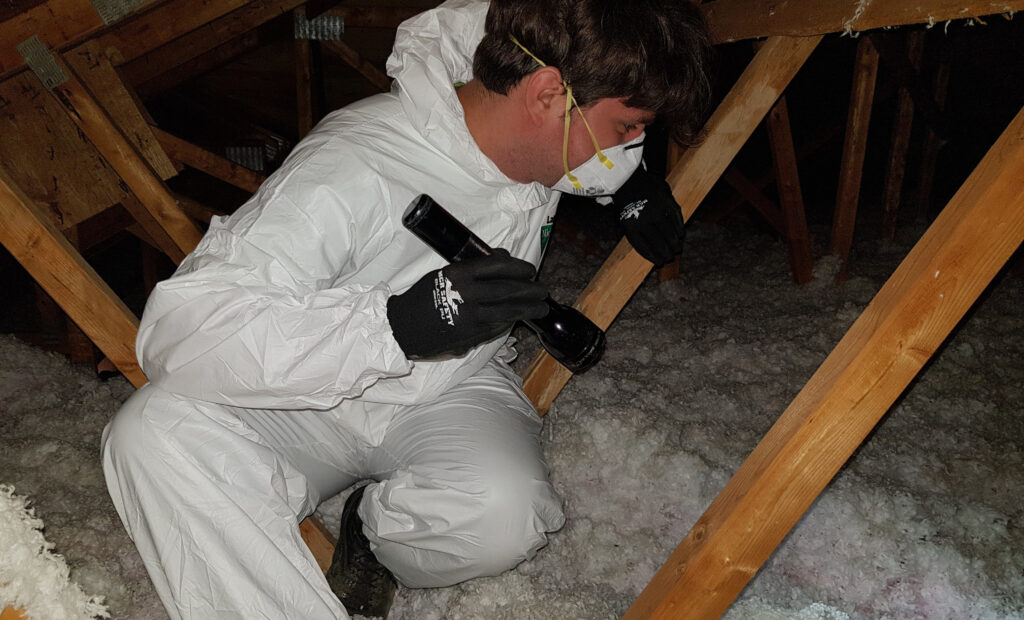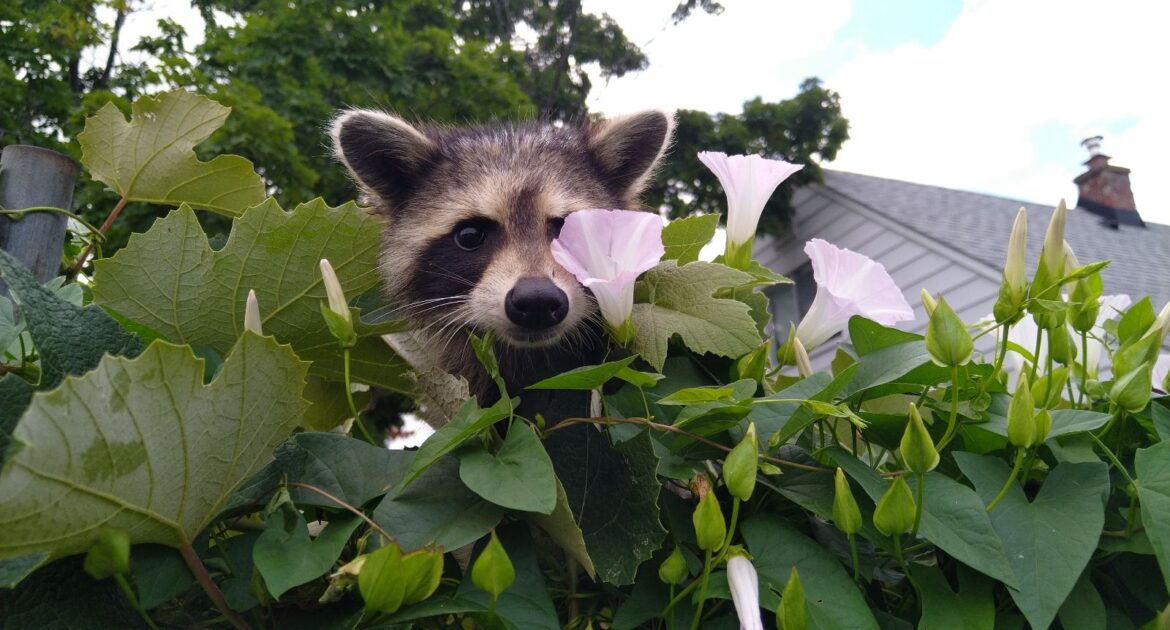Raccoons may seem like cute and harmless creatures, but they pose a serious risk to both your health and home. If you live in Prince George’s County and are dealing with an infestation, it’s crucial that you take action to have them removed as soon as possible. Not only do they carry a plethora of diseases that can be transmitted to humans, but they are also notorious for causing extensive and costly damage to homes and property.
In this blog article, our Skedaddle experts delve deeper into the risks associated with raccoon removal, explore what diseases raccoons carry, and why raccoons are considered dangerous. By understanding the risks associated with them, you’ll be better equipped to keep your home and loved ones safe and protected.
Why Raccoons are Dangerous
It’s the charming, inquisitive nature of raccoons that often gets them into trouble. Attracted by the scent of food waste, they are frequently found foraging in trash bins and gardens, making their way into homes and garages. Though they may seem harmless, their behavior represents a genuine threat because they often carry harmful diseases that pose significant health risks.
The Risk of Rabies
Rabies is by far the most dangerous disease carried by raccoons. It’s a viral infection that affects the central nervous system, leading to a myriad of severe symptoms, eventually resulting in death if not treated promptly. Few creatures are as proficient at spreading this disease as raccoons, thanks to their widespread population and proximity to human habitats.
Roundworm Infections
Another significant health risk is the roundworm infection. Raccoons are common carriers of Baylisascaris procyonis, a type of roundworm parasite. These parasites live in their intestines and eggs are excreted through their feces. Once dried, these eggs become airborne and can unwittingly be inhaled by humans, leading to serious health complications. Regular cleanup is essential, but only a professional can guarantee complete removal and disinfection from potentially harmful parasites.
Raccoons and Structural Damage
Apart from health risks, raccoons can also cause substantial structural damage to properties. Their strong, dexterous hands allow them to rip open vents, remove soffits, and enlarge small holes to gain access to potential nesting sites. They are also known to tear up insulation, gnaw on wires (raising the risk of fires), and cause significant disturbance with their nocturnal habits.

What Diseases Do Raccoons Carry?
In addition to Rabies and Roundworms, raccoons are vectors for a variety of pathogenic organisms, some of which can lead to serious health conditions. They can transmit diseases such as Leptospirosis, Giardiasis, and even a rare form of Tuberculosis, each carrying their own health risks and treatment measures.
Leptospirosis
Leptospirosis is a bacterial infection that raccoons can acquire from contaminated soil and water, or through contact with infected animals. Humans can get infected by coming into contact with raccoon urine or by inadvertently consuming food or water contaminated with the bacteria. Symptoms of Leptospirosis can range from a mild flu-like illness to serious complications such as kidney damage, liver failure, and meningitis.
Giardiasis
Raccoons are also carriers of Giardia lamblia, a parasite that causes Giardiasis. This disease, often associated with contaminated drinking water, presents with symptoms like diarrhea, abdominal cramps, bloating, and nausea. In severe cases, it can lead to weight loss and malnutrition. Pets, especially dogs, can also become infected by this parasite, so it’s crucial to keep these animals away from areas frequented by raccoons.
Tuberculosis
A less common but significant disease carried by raccoons is a form of Tuberculosis caused by Mycobacterium bovis. While it is rare for humans to contract this form of Tuberculosis, it’s not impossible, especially if your immune system is compromised. Bovine Tuberculosis in humans can cause a persistent cough, fatigue, weight loss, and may even spread to other organs.
Managing and Mitigating Raccoon Infestations
If you’ve noticed signs of a raccoon infestation in your home, immediate action is essential. Long-term presence of raccoons or repeated invasions can increase the risk of disease spread. As part of the managing and mitigating process, it’s important to adopt appropriate strategies that prevent further invasions. Skedaddle’s wildlife control experts recommend these key strategies:
- Secure Trash Cans: Making it tougher for raccoons to access your trash can discourage them from lingering around your property. Use heavy-duty trash cans with secure lids, or add a weight or lock to keep your existing trash cans shut.
- Eliminate Food Sources: Raccoons are attracted to readily available food sources. Keeping your property clean, removing pet food overnight, and picking up fallen fruits from trees can help.
- Seal Possible Entry Points: Check your home for potential entry points like holes, loose vents, or gaps in your roofing or under your porch. Seal these areas properly to prevent access.
While these measures can considerably reduce the chances of a raccoon infestation, there is no foolproof method for preventing raccoon entry or re-entry. Thus, in case of an infestation, professional help should be sought.
When to Call Skedaddle for Raccoon Removal
So, when is the right time to call Skedaddle for raccoon removal in Prince George’s County? It’s always recommended to seek professional help the moment you notice the first signs of possible raccoon presence within or around your home. This could be as simple as noticing overturned garbage bins, scratched or damaged property, or hearing unusual noises, especially during late-night hours when these creatures are most active.
- Overturned and damaged garbage bins: This is one of the most common signs of a raccoon invasion. If you often find your trash bags ripped open and leftovers spread around your yard, chances are you may be dealing with raccoons.
- Sounds and noises: Loud thumping, scratching noises, or high-pitched chittering sounds coming from your attic or walls, especially during the night, could indicate the presence of raccoons.
- Structural damage: Raccoons are capable of causing significant damage, such as ripped open vents or soffits, in their attempt to gain access to your home. Any such signs should not be ignored.
Raccoon removal should never be attempted by yourself or someone who lacks the necessary professional training. Attempts at amateur removal can expose you and your loved ones to serious health risks and can often lead to incomplete removal, allowing the problem to reoccur. Not only can professionals like us at Skedaddle ensure complete removal, but we are also equipped to handle the necessary clean-up and disinfection processes that follow.
The Skedaddle Process
As experienced wildlife control experts, Skedaddle follows a comprehensive three-step process for effective raccoon removal.
- Assessment: The first step involves a detailed assessment of the property to identify the extent of the infestation, potential entry points and evidence of damage or disease. This step forms the foundation for our removal strategy.
- Removal: In the second step, we professionally and humanely remove the raccoons from your property. Our focus is on ensuring the safety of the animals while preventing any further property damage or risk to human health.
- Exclusion and Prevention: The final step is to secure your property against future infestations. This involves sealing off potential entry points and providing guidance on practices for reducing attractants around your property, which may invite these animals again.
Raccoon infestations come with significant risks to your health and your home. As experts in raccoon removal, we at Skedaddle are committed to ensuring your family and home remain safe from the dangers that these animals pose. If you suspect a raccoon problem, don’t hesitate to contact us for comprehensive, safe, and reliable raccoon removal services in Prince George’s County, Maryland.




